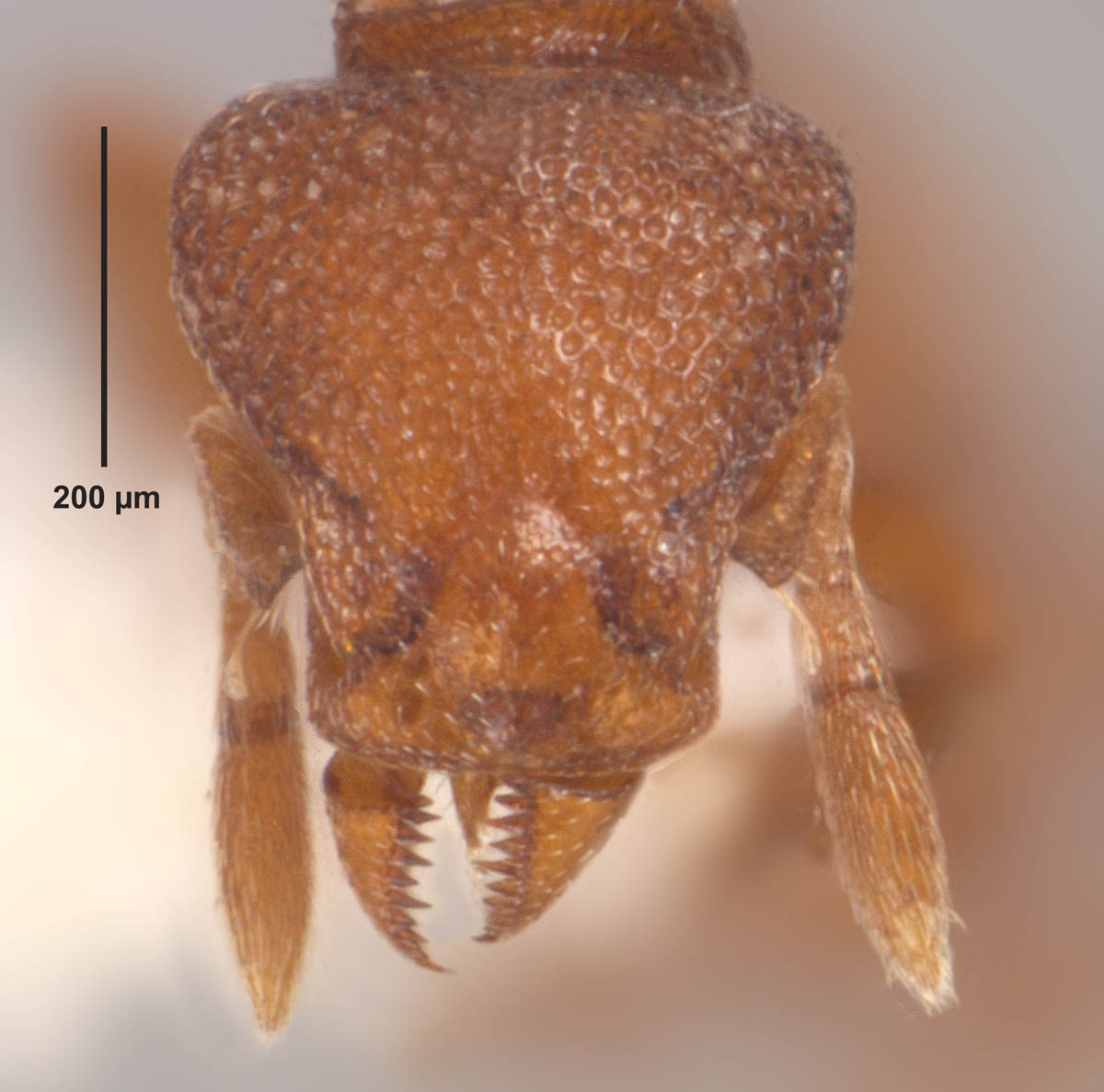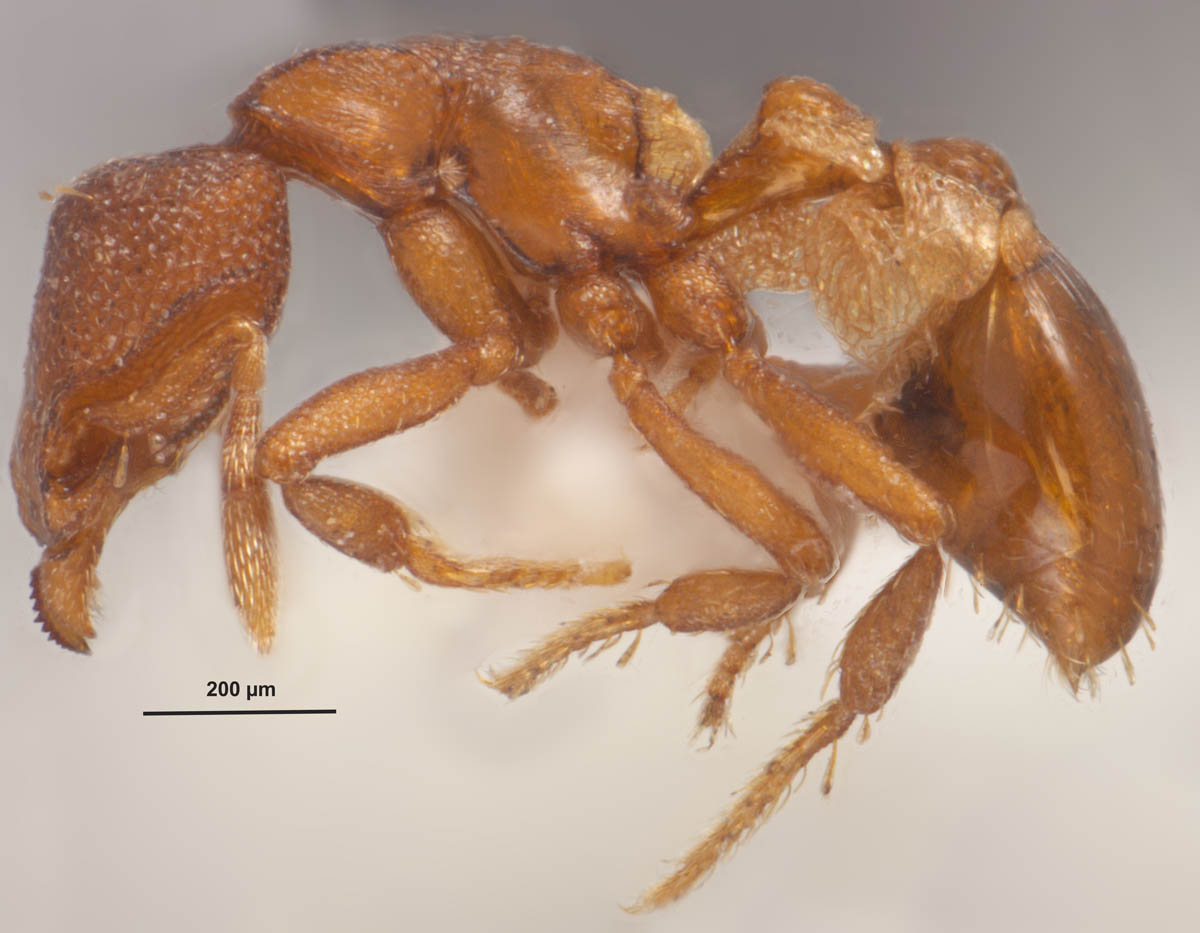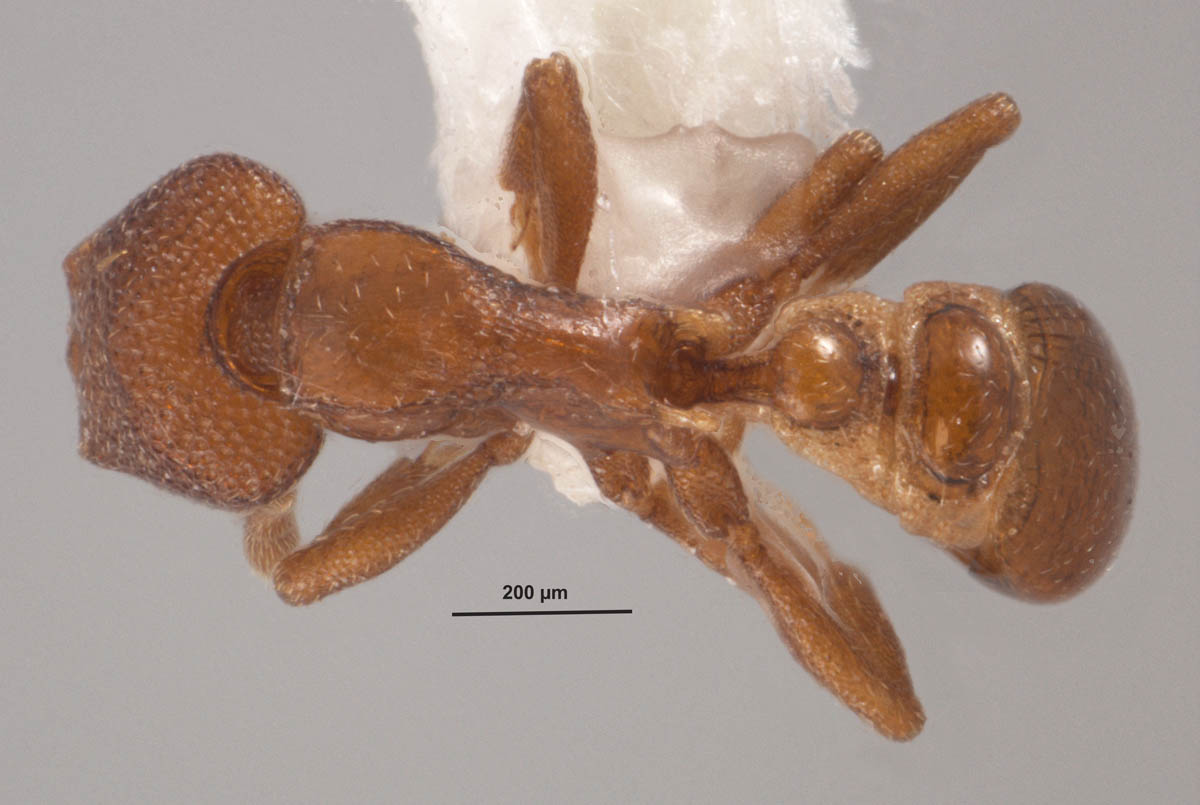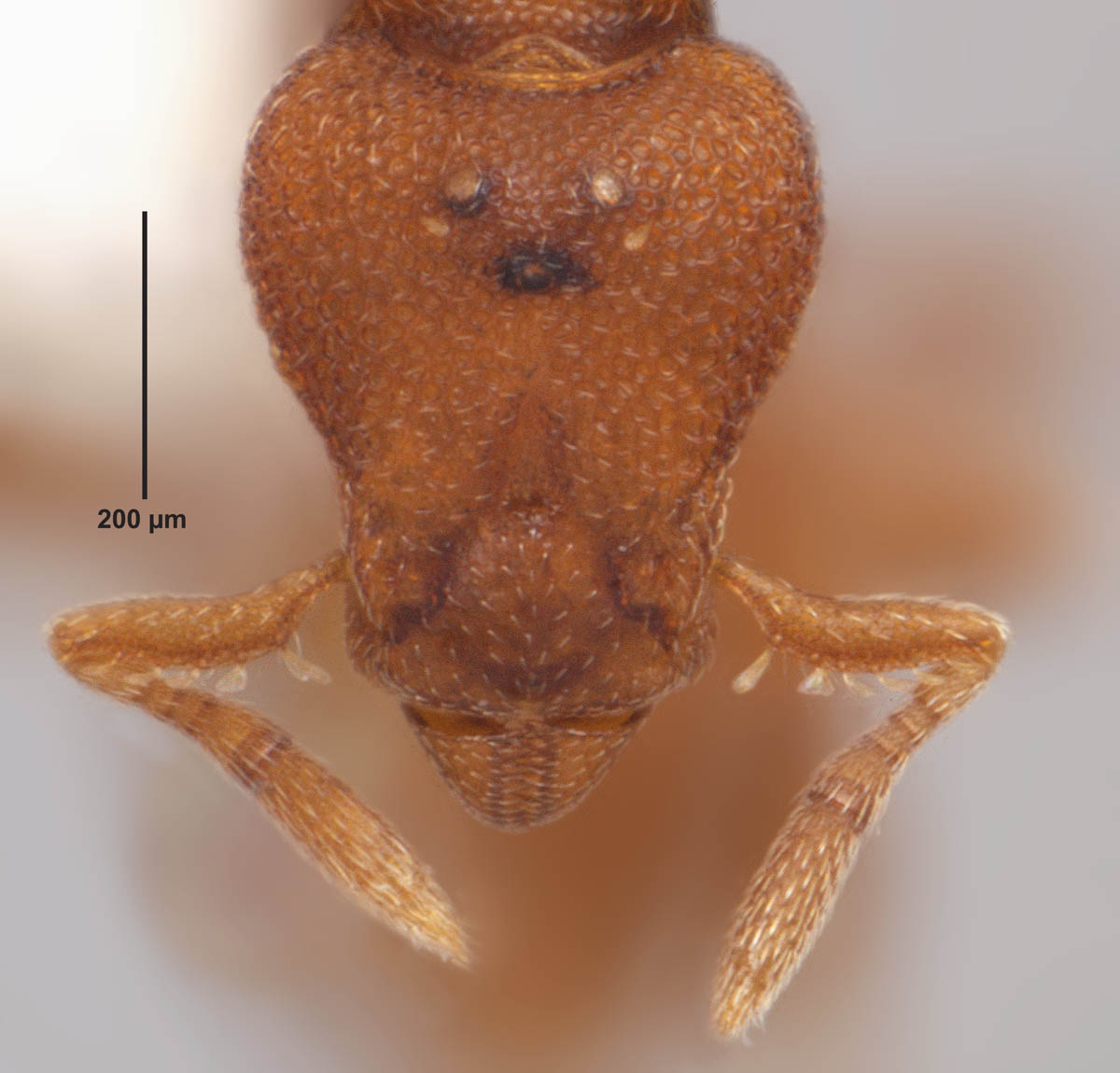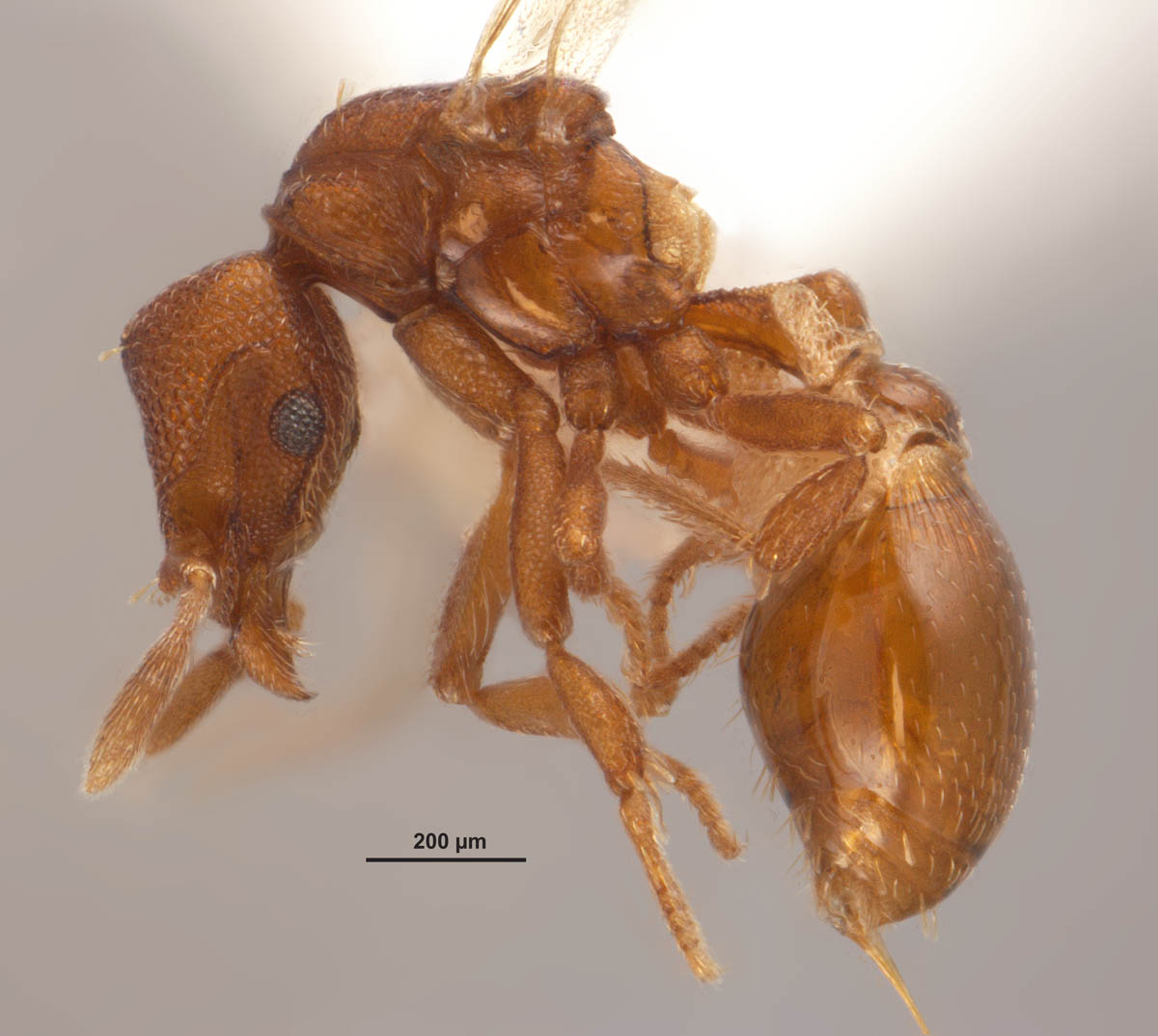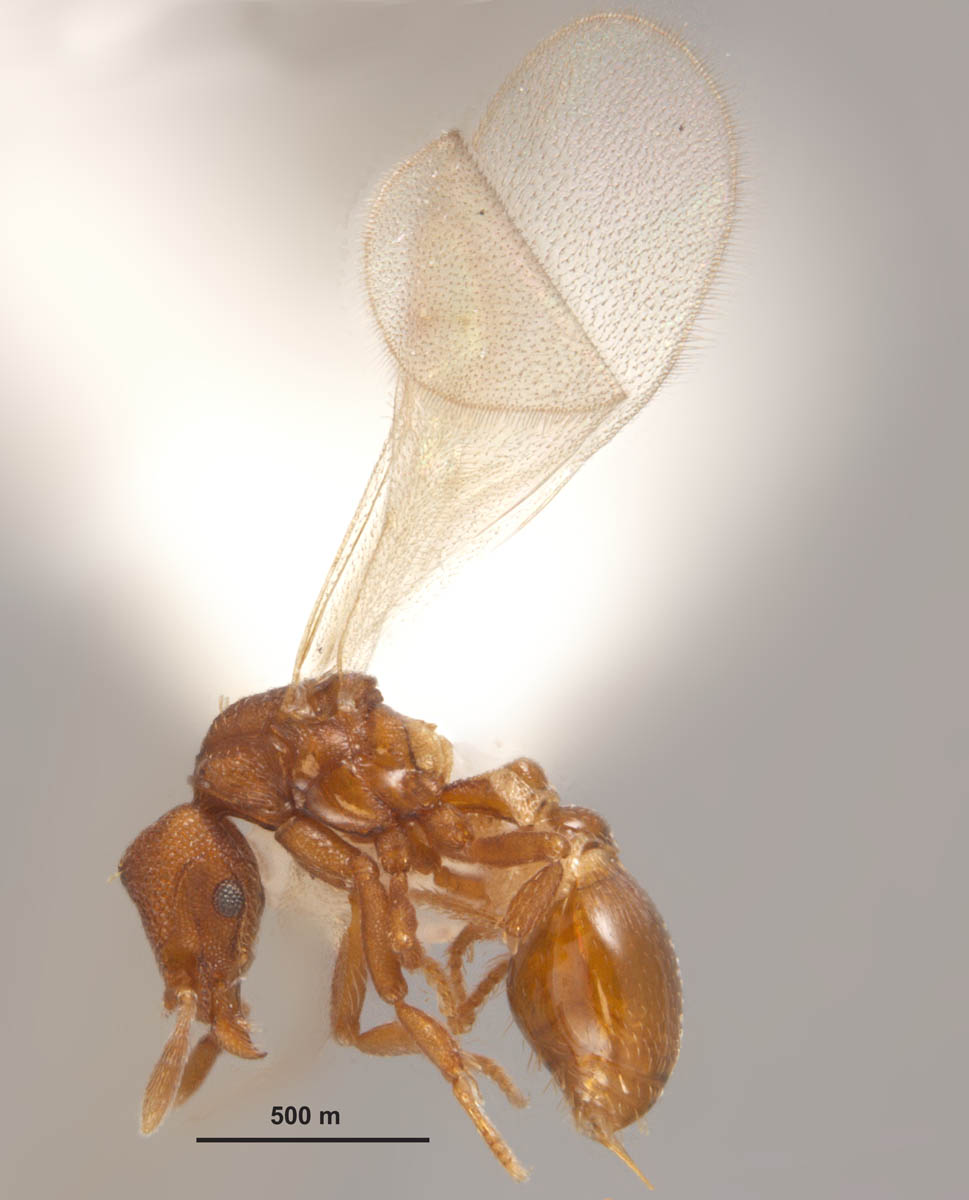Subfamily MYRMICINAE Authors: Joe A. MacGown and Ryan J. Whitehouse |
||
Strumigenys membranifera, full face view of worker (MS, Noxubee Co.) (photo by Joe MacGown) |
Strumigenys membranifera, lateral view of worker (MS, Noxubee Co.) (photo by Joe MacGown) |
Strumigenys membranifera, dorsal view of worker (MS, Noxubee Co.) (photo by Joe MacGown) |
Strumigenys membranifera, full face view of queen (AL, Baldwin Co.) (photo by Joe MacGown) |
Strumigenys membranifera, lateral view of queen (AL, Baldwin Co.) (photo by Joe MacGown) |
Strumigenys membranifera, lateral view of queen (AL, Baldwin Co.) (photo by Joe MacGown) |
Introduction In the US, members of the genus Strumigenys can easily be distinguished from other genera by their minute size; 4-6 segmented antennae; elongate, snapping mandibles; unique and often "bizarre" pilosity, and presence of "spongiform lobes" beneath the petiole and postpetiole (Bolton 1999). Strumigenys membranifera has a pantropical distribution and has been spread around the world through human commerce. S. membranifera have small eyes that are best at seeing motion, which is their main means of finding prey (Wilson, 1954). Unlike some other Strumigenys species, S. membranifera have triangular mandibles that are used for immobilizing prey so they can more easily sting it instead of long mandibles used for stunning their prey. They can also be found nesting in a variety of different locations and tend to venture into dry, open soil more than other species in the genus. Taxonomic History (Bolton 2013) Diagnosis Identification Queen: HL 0.51-0.53mm, HW 0.44-0.46mm, SL 0.24-0.25mm, EL 0.08-0.09mm, MeSL 0.58-0.60mm (n=5) (MEM specimens). Entire body reddish brown. Head wedge-shaped, widest near posterior margin, anterior edge (including clypeus) abruptly truncate; deep antennal scrobes present on sides of head; in full face view, entire head, except clypeus, with tightly woven reticulation; clypeus mostly lacking sculpture, shining; a single spatulate erect seta present on each posterior corner of head; otherwise all setae present on head simple, appressed. Eyes are well developed located on the ventral side of the antennal scrobe; three ocelli often with black coloration around them. Mandibles triangular, with distinct dentition all along their inner face (dentition as in worker); distinct, transverse edge at the base of the mandibles parallel to the anterior clypeal margin. Antenna 6-merous; scape short, dorsoventrally flattened, the dorsum and venter converging anteriorly so that the leading edge is a sharp flange or even a thin lamella; leading edge of scape with a row of large spatulate hairs, one or more of which are curved toward the base of the scape; pedicel about as long as funicular flagellomere 2-3 and about as long as flagellomere 3; apical flagellomere greatly enlarge, forming a 2 segmented club with flagellomere 3. Mesosoma enlarged, mesoscutellum overhangs propodeum; pronotum, mesoscutum, mesoscutellum, anepisternum, and upper metapleuron with reticulate sculpture; katepisternum and lower metapleuron lacking sculpture, shiny; a pair of feebly clavate setae present near humeral area; with scattered to moderate short, simple, appressed setae present dorsally. Propodeum with broad lamella, which mostly conceals propodeal teeth. Wings, if present, lacking pigmented veins, stigma absent, with fringe of setae along wing edges apically and on ventral sides of wings to about midway toward base. Petiole distinctly pedunculate, in dorsal view, node circular, shiny, with a few scattered simple, appressed setae; in dorsal view, postpetiole about twice as wide as petiole, oval, shiny, with a few simple, appressed setae; spongiform tissue heavily developed on both waist segments. Gaster very shiny, lacking sculpture except for longitudinal carinae present dorsally at anterior edge of first gastral tergite; scattered, simple, appressed setae present; a few elongate, erect, clavate setae present apically; sting present. Male: No specimens available. Biology and Economic Importance Even though S. membranifera is widespread, little in known about the impact of this species on its non-native environments. It is not considered to be a pest or a nuisance since it is rarely encountered by the average person. Pest Status Distribution Australian: Australia, Papua New Guinea, Federated States of Micronesia, Fiji, Guam, Hawaii, Indonesia, Marshall Islands, New Guinea, Northern Mariana Islands, Samoa, Solomon Islands, Tonga, Wallis and Futuna Islands (AntWeb.org and AntWiki.org). U.S. Distribution: AL, AR, AZ, CA, FL, GA, HI, LA, MS, NC, SC, TX (AntWeb.org and MEM). Acknowledgments Literature Cited Bolton, B. 1983. The Afrotropical dacetine ants (Formicidae). Bulletin of the British Museum (Natural History). Entomology 46:267-416. Bolton, B. 1999. Ant genera of the tribe Dacetonini (Hymenoptera: Formicidae). Journal of Natural History 33:1639-1689. Bolton, B. 2000. The ant tribe Dacetini. Memoirs of the American Entomological Institute 65:1-1028. Bolton, B. 2013. Bolton World Catalog Ants. Available online: http://www.antweb.org/world.jsp. Accessed March 2016. Brown, W. L., Jr. 1948. A preliminary generic revision of the higher Dacetini (Hymenoptera: Formicidae). Transactions of the American Entomological Society 74:101-129. Brown, W. L., Jr. 1949. A correction. Psyche (Cambridge) 56:69. Emery, C. 1869. Enumerazione dei formicidi che rinvengonsi nei contorni di Napoli con descrizioni di specie nuove o meno conosciute. Annali dell'Accademia degli Aspiranti Naturalisti. Secunda Era 2:1-26. Emery, C. 1916 ("1915"). Fauna entomologica italiana. I. Hymenoptera.-Formicidae. Bullettino della Società Entomologica Italiana 47:79-275. Wetterer, J.K. 2011. Worldwide spread of the membraniferous dacetine ant, Strumigenys membranifera (Hymenoptera: Formicidae). Myrmecological News. Vol. 14 JAN 2001. 129-135. Wheeler, G. C.; Wheeler, J. 1991. Instars of three ant species. Psyche (Cambridge) 98:89-99. Wilson, E. O. 1954 ("1953"). The ecology of some North American dacetine ants. Annals of the Entomological Society of America 46:479-495. Links |
||


